How Mobile Apps Are Helping Kolkata Businesses Grow Faster
For years, a strong website was enough. Today? Your customers, your staff, and even your vendors are living their lives…
The relationship between patients and healthcare providers is undergoing a rapid, fundamental transformation. We’ve moved from paper-based records and endless phone tag to a world where health management is literally in the palm of our hands. This digital shift, accelerated by global events, is not just a convenience—it’s an absolute necessity for modern healthcare delivery.
The numbers speak for themselves. The global digital health market is projected to grow from an estimated $427.24 billion in 2025 to over $1.5 trillion by 2032, exhibiting a massive CAGR of 19.66%. A significant driver of this growth is the adoption of mHealth (mobile health) applications. Moreover, studies show that nearly one in three adults in the U.S. uses a wearable device to track health, and the average number of digital health tools used by physicians grew to 3.8 in 2022, up from 2.2 in 2016. Patients are actively seeking digital tools, and healthcare institutions are responding with robust platforms.
This is where the Patient Management Application (PMA) comes in. It’s the essential technological backbone that binds the patient journey together, moving a hospital or clinic from being a reactive service provider to a proactive healthcare partner. Building a Patient Management Application is no longer a luxury; it’s the foundation for future-proof, efficient, and patient-centric care.
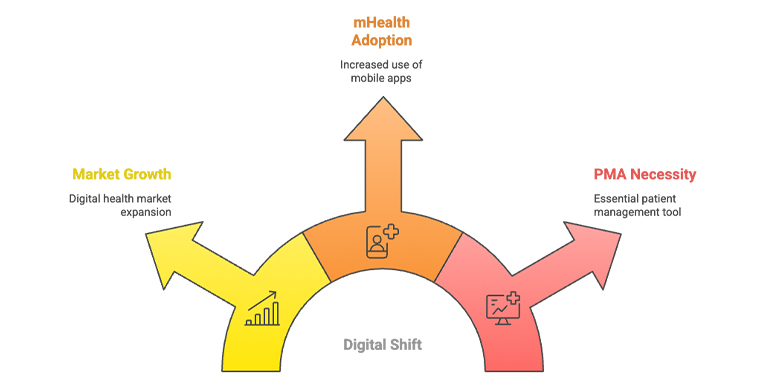
A Patient Management Application (PMA) is a comprehensive software solution—often delivered as a mobile app, web portal, or a hybrid platform—designed to streamline and automate the administrative and clinical workflows associated with patient care. Think of it as the ultimate digital coordinator for both the patient and the healthcare facility.
In simple terms, a PMA’s primary purpose is to move patient-related tasks from fragmented, manual processes to a single, integrated digital environment.
For example, instead of a patient spending 15 minutes on a phone call to reschedule an appointment, they can do it in three taps on the app. Instead of a doctor searching through a paper chart for lab results, they access the patient’s complete, longitudinal Electronic Health Record (EHR) instantly from their dashboard. This real-world efficiency transforms patient satisfaction and frees up staff to focus on actual care.
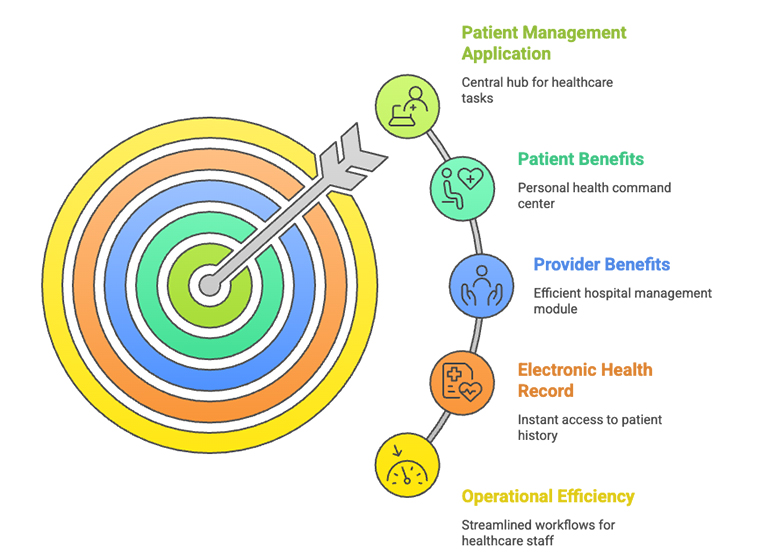
To be successful, a Healthcare App Development project must incorporate features that serve both sides of the care equation—patients and providers. The following are the essential components of a robust Patient Management Application:
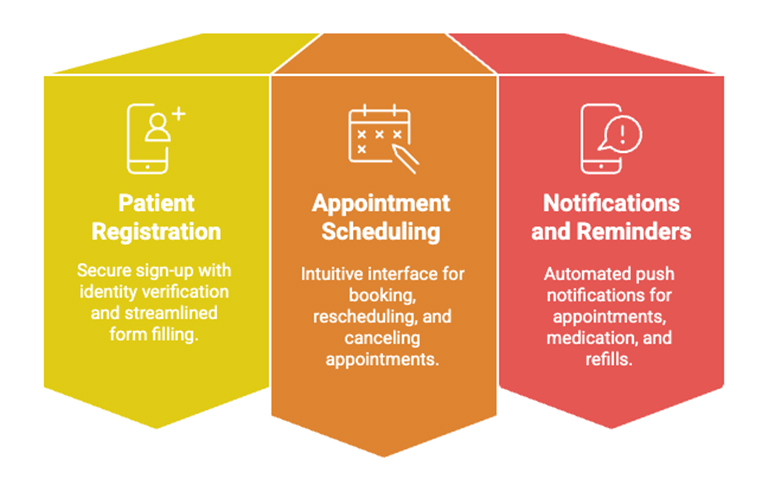
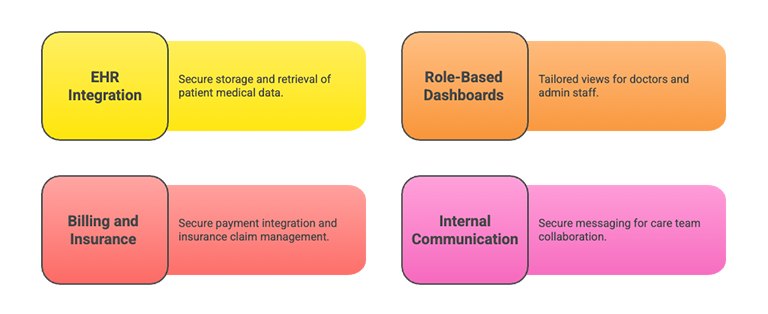
Developing a feature-rich, compliant Patient Management Application requires a structured, multi-stage approach. Rushing this process, particularly the security and testing phases, is a recipe for disaster in the sensitive healthcare industry.
Identify the problem your app will solve. Are you targeting specialty clinics, large hospitals, or chronic disease management? Analyze existing Hospital Management System solutions and competitor PMAs to find gaps and opportunities for innovation. Define your Unique Value Proposition (UVP).
Based on your research, create a detailed feature list (as outlined in Section 3). Develop wireframes (skeletal blueprints) and a Minimum Viable Product (MVP) scope. The MVP should include the essential core features—secure login, appointment booking, and basic EHR viewing—to launch quickly and gather real user feedback.
In healthcare, design is paramount. The interface must be intuitive, clean, and accessible (e.g., following WCAG standards) for users of all ages and technical literacy. A confusing interface can lead to medication errors or missed appointments. Focus on clear navigation, readable fonts, and minimizing clicks for core tasks.
The tech stack determines your app’s performance, scalability, and security. For modern, cross-platform PMAs, common choices include:
Real-World Insight: Leveraging a modern stack like React Native + Node.js allows for faster development and lower maintenance costs than building separate native apps for iOS and Android.
Modern PMAs move beyond simple record-keeping. Integrate Artificial Intelligence (AI) and Machine Learning (ML) to:
Testing in a healthcare app is a rigorous process, including functional testing (does the feature work?), usability testing (is it easy to use?), and, most importantly, Security Testing (Penetration Testing, Compliance Audits). The application must be flawless and breach-proof.
Once certified and compliant, the app is deployed to the App Stores (iOS/Android) and/or web servers. Post-launch, continuous maintenance, bug fixes, updates, and scalability monitoring are essential to keep the platform secure and high-performing.
Data security is the cornerstone of any successful Healthcare App Development project. Patient data is classified as Protected Health Information (PHI) and is subject to the strictest regulations worldwide. A data breach can lead to massive fines, loss of public trust, and legal action.
A global-ready PMA must be built with a ‘Security-by-Design’ philosophy to meet key regulatory standards:
Choosing the right development partner is the difference between a compliant, scalable PMA and a costly failed project. Ndimension Labs is a leading software development company that specializes in cutting-edge Ndimension Labs Healthcare Solutions, particularly in the highly regulated health tech space.
We bring years of expertise in crafting secure, high-performance, and user-friendly digital platforms for hospitals, clinics, and health-tech startups. Our core strengths include:
“At Ndimension Labs, we don’t just code — we create digital healthcare experiences that improve patient outcomes and streamline hospital operations.”
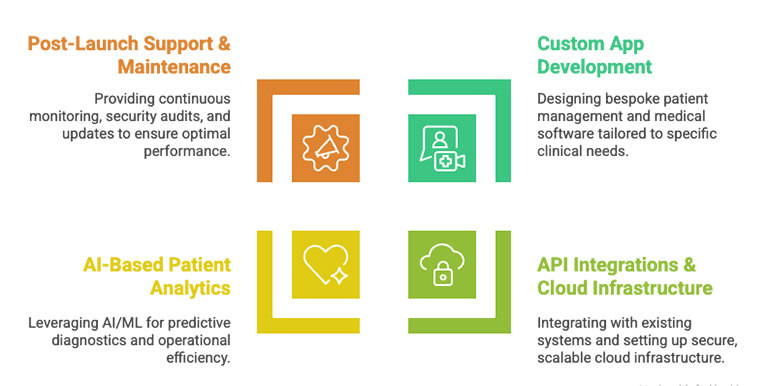
The cost of building a Patient Management Application is a major factor, driven by complexity, feature set, and the chosen tech stack. Costs can vary widely depending on the type of application:
| App Tier | Estimated Cost Range (USD) | Key Features |
| Basic PMA (MVP) | $10,000 –
$15,000+ |
Simple scheduling, patient registration, basic profile, static information view. |
| Mid-Level PMA | $30,000 –
$80,000+ |
All basic features plus secure messaging, partial
EHR view, basic payment gateway integration, and one regulatory compliance (e.g., HIPAA). |
| Enterprise-Gr ade PMA | $100,000 –
$300,000+ |
Full EHR/EMR integration, AI analytics, telemedicine module, custom provider dashboards, multiple regulatory compliance (HIPAA, GDPR), and complex billing/insurance logic. |
To get an accurate estimate for your unique Healthcare App Development project, connect with Ndimension Labs today.
The next few years promise a radical transformation in how PMAs function, driven by pervasive technology. Investing in a future-ready application now is critical.
The global healthcare mobile application market is projected to reach over $1 trillion by 2030, reflecting a staggering CAGR of 45.2% from 2025 to 2030. This growth is a clear indicator that the digital patient journey is the future.
Building a Patient Management Application is a strategic investment in efficiency, compliance, and, most importantly, patient trust. It’s about more than just software; it’s about creating a smarter, more accessible healthcare ecosystem. By meticulously planning the features, prioritizing security, and choosing a development partner with deep expertise in regulated health tech, you can build a platform that truly revolutionizes care delivery.
The future of healthcare is digital, integrated, and intelligent. Don’t be left behind in the era of paper and phone calls.
Let’s work together to build smarter healthcare solutions — with Ndimension Labs by your side.
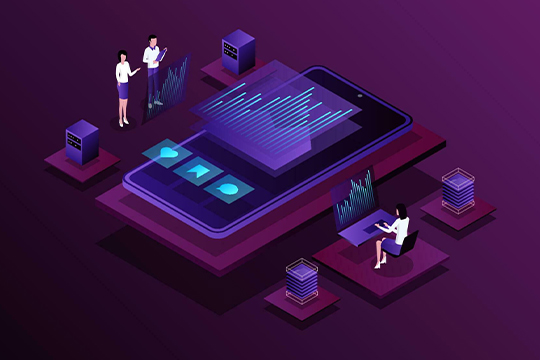
For years, a strong website was enough. Today? Your customers, your staff, and even your vendors are living their lives…

Building a High-Performing Hotel Booking Mobile App The days of relying solely on front-desk calls or travel agents for bookings…
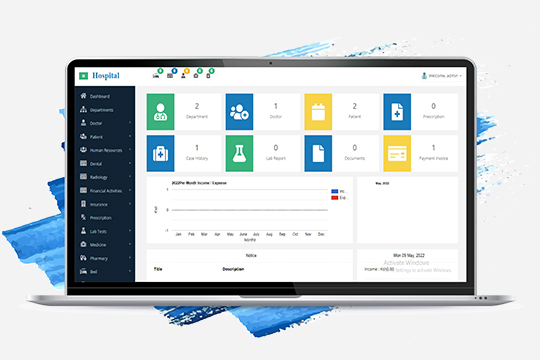
The Rise of Digital Healthcare: Transforming the Patient Journey The relationship between patients and healthcare providers is undergoing a rapid,…